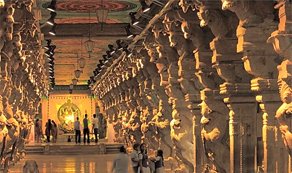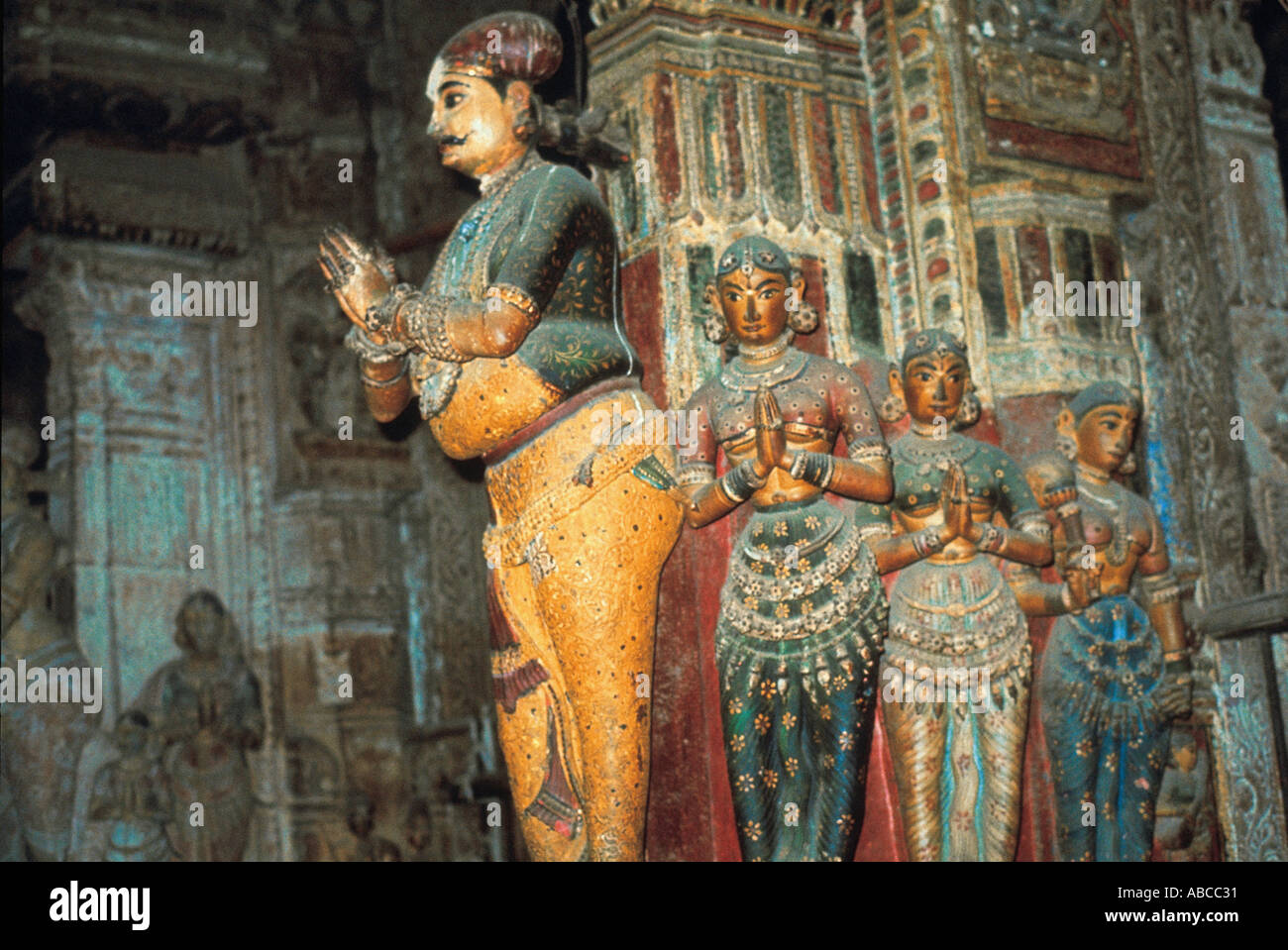It is thick with the smoke of sacrifices and many other pleasing smells. It blows through the palace of the great Pandya king, who wears on his broad chest a chain of gold that the king of the gods once gave him. This breeze that carries strange and varied smells about the country is very different from the other wind that blows from the Podiyil hill, whose glory was sung by faultless lounges of Tamil bards. The wealthy city is not far off, and you need have no fear. Even if you go there alone, you will meet no danger on your way.”
– -Ilangovadigal in Cilappatikaram [one of the Sangam epics composed in the third century C.E] about Madurai
Introduction:
Madurai, also known as Thoonga Nagaram (the city that never sleeps), is located on the banks of the Vaigai River. Home to the first and last Sangam, this hustling city is filled with endless legacy, glory, and history. The city finds a place for itself in the Arthashastra written by Kautilya during the Mauryan period, and in the works of Roman historians Pliny the Younger, Ptolemy, the Greek geographer Strabo, and also in the Periplus of the Erythraean Sea. After the end of the Sangam era, Madurai was ruled by multiple kingdoms, including the Pandyas, the Sultanate, the Vijayanagar Empire, the Nayakas, etc., before eventually ceding to the British Raj. The architecture of this celebrated and sublime city is centred around the Meenakshi Amman Temple, which is considered a marvel of Dravidian architecture.
In the city’s centre is the Meenakshi Amman Temple, which houses Meenakshi Amman, the main deity, and her consort, Sundareswarar. The temple was built under the Pandya king Kulasekara Pandya in the 7th century CE. The only surviving parts of the temple constructed by the Pandya king comprise a gopuram, the Sundareswarar shrine, and the Meenakshi Amman shrine. The temple was destroyed during the invasion of Malik Kafur in the 14th century and was later rebuilt by the Nayakas, resulting in the grand structure that we witness today.

Source: Wikipedia [ Image of the Madurai Meenakshi Amman temple]
Meenakshi Amman temple under the Nayakas:
During the Nayaka rule in the 16th and 17th centuries, the temple was continuously restored and expanded under multiple kings. According to art historians, the Nayaka rulers followed the Shilpa shastras [ ancient architectural rules] to construct the temple. The work of reviving and rebuilding the temple was initially taken up by Vishwanatha Nayaka in 1560 and was then followed by all the Nayaka kings. Some of the important contributions came during the period of Thirumalai Nayakar, an important nayaka king, who, under his reign, constructed many complexes inside the temple. His major contributions are the Vasantha Mandapam [corridor of spring] and the Kilikoondu Mandapam (corridor of parrots). The temple was further expanded during the rule of Rani Mangammal. Under her rule, the corridors of the temple tank and Meenatchi Nayakar Mandapam. The structure was further rebuilt under the supervision of Ariyanantha Mudaliyar, the prime minister of the Nayaka dynasty.

Source: Endangered archives. [Magnificent Unjal Mandapam built during the Period of the Nayakas in the 16th century]

Source: flickr [ Image of a Kumbhapanjara motif]
Pottramaraikulam:
Meenakshi Amman temple is undoubtedly a symbol of many architectural wonders, and one of the most important structures of the temple is the Pottramaraikulam [Golden lotus pond]. It is believed that the pond was once home to several golden lotuses, hence the name. Located right after the eastern tower entrance, adorned with an intricately crafted gopuram, you get to witness the majestic pond encompassing one acre. The pond measures 165 feet in length and 120 feet in width, and is surrounded on all four sides by corridors lined with intricately carved pillars. According to the legends, another famous story surrounding the water in the pond is that it was also used to test the authenticity and the quality of the literature composed, where good literature would remain afloat, while bad literature would sink.

Source: flickr [Image of Pottramarikulam]
Thousand Pillar Mandapam:
The Thousand Pillar Mandapam, also known as Ayirankal Mandapam, was constructed by Ariyanatha Mudali, a military general under the rule of Krishnan Virappa Nayaka. There are 985 columns in the mandapam, each intricately crafted and sculpted. The sculptures in the mandapam include stories of Harichandra Puranam and the Mahabharata. Apart from that, an important sculpture on one of the pillars shows the wedding of Meenakshi — it portrays Lord Shiva as the groom and Meenakshi as the bride. The mandapam, in addition to this, is decorated with other prominent motifs such as the lotus flower, a stylised cluster or bunch of leaves, and kumbhapanjara, an architectural feature resembling a pillar or niche with a pot-shaped base, one of the prevalent Nayaka motifs. In addition to this, these pillars also reflect the polity, society, and economy of the period. We get to see the army base, the portraits of kings, ornaments used in the period, musical instruments that were played, etc., through the figures on the pillars.

Source: Pinterest [Image of 1000 pillar mandapam ]
 Source: Wikipedia. [Image of King Thirumalai Nayakar in one of the temple corridors]
Source: Wikipedia. [Image of King Thirumalai Nayakar in one of the temple corridors]
The Temple structure and Gopurams:
The temple takes up 14 acres of space and is enclosed with huge walls on all sides, which were built in response to invasions and wars. This grand structure has four Raja gopurams or majestic towers that look identical and act as gateways on each side. The temple has fourteen gopurams in total, leading the people to the central shrine where the deities Meenakshi and Sundareswarar are situated. The Sundareswarar Gopuram is the oldest ‘gopuram’ of the temple and was built by Kulasekara Pandya. The ‘gopuram’ serves as a gateway to the Sundareswarar shrine. Some of the other major gopurams include Chitrai gopuram, Kadakka gopuram, etc. The temple, apart from this, embodies well-crafted pillars, mandapas, ashrines, lakes and corridors.

source: temples of South India [ the Raja gopuram decorating the entrance of the temple]
Current status:
At present the Madurai Meenkshi Amman temple comes under the control of stae government and is maintained under Hindu Religious and Charitable Endowments Department. The temple till today is famous for it’s Chitirai thiruvizha that was started c. around 700 years ago. Considered as one of the crowded events of Tamilnadu , this festival celebrates the edding of of Goddess Meenakshi and Lord Sundareshwar. Traditional art forms like Karagattam, Kollattam, Silambattam, and Oyilattam are showcased during the divine procession, highlighting the people’s reverence for cultural traditions. In the recen times several measures have also been taken up by the government and art enthusiasits to protect the temple and its history. One among them is the initiative to save the Murals of the temple, The Department of Hindu Religious and Charitable Endowments (HR & CE), the Archaeological Survey of India (ASI), and the State Department of Archaeology have undertaken measures to preserve these murals.
source : Hindu Mural in themple
 Conclusion:
Conclusion:
This architectural wonder, considered one of the pinnacles of Dravidian architecture, is imbued with meticulously crafted pillars, mandapas and multi-storey gopurams. Each of them is filled with legends, history and myths. Right from the ancient period till now, all the major makers of the city are situated around the temple. According to the evidence from maps and manuscripts of the ancient period, we get a glimpse of the town planning of this landscape. As is already well known, the ancient south Indian temple towns are designed by placing the temple complex at the centre, and therefore it serves as a major connection for all the events and festivals. The present map of the town also echoes the same pattern. Madurai continues to function with the temple as an important site for all the commercial activities, and continues to hold the legacy of being a cultural hub.
The eternal city that never sleeps is crowned with this beautiful temple in the centre.

Source: Wikipedia
[The major deities of the temple, Meenakshi and Sundareswarar, the image gives a glimpse of Meenakshi getting married to Sundareswarar
And the left side is lord Visnu, the brother of Meenakshi.]
References:
https://gurujnanam.org/wp-content/uploads/2018/12/Meenakshi-Temple-Madurai.pdf
Janakarajan, I., & Behera, P. (n.d.). The glory of Meenakshi Amman Temple, Madurai, Tamil Nadu, India. Presidency University, School of Design, Bengaluru, India.
Rajagopal, S., & Praiya, R. (2023). Thousand-pillar mandapa in Meenakshi Sundareswarar Temple, Madurai, Tamil Nadu – A study. XCVI, 66–72.
Devi, N. (2020). The Features of Madurai Meenakshi Amman Temple – A Study. Shanlax International Journal of Arts, Science and Humanities. 7. 110-114. 10.34293/sijash.v7i4.1616.
https://www.thedecorjournalindia.com/meenakshi-temple-architecture




